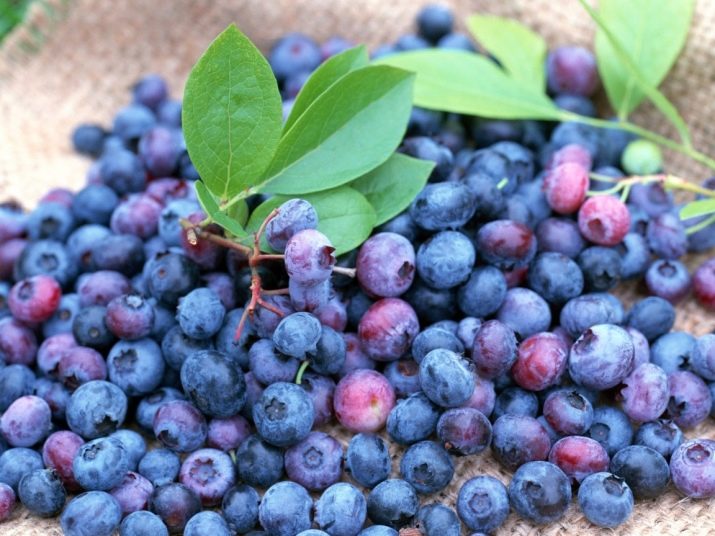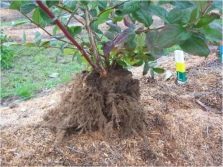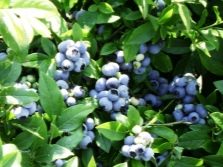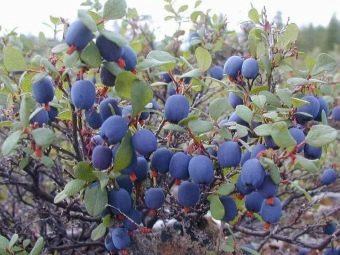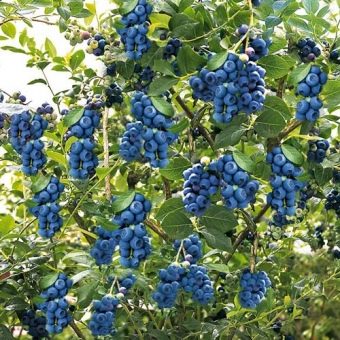Blueberry tall: description of varieties and cultivation guidelines

About the benefits of blueberries can talk for a long time. This berry is rich in vitamins, so it is used in food to improve immunity and promote health. It is very sweet and tasty, so various desserts are made of it: jam, jams, juices and other goodies.
Features of culture
In nature, forest blueberries are usually short and rarely reach a meter height, and gardeners plant tall shrubs on private plots, which produce larger than wild berries. Blueberries are considered shrubs, but some varieties can reach up to 4 m in height and resemble trees. Most often on the garden plantations are grown varieties 1.5-2 m in height.
Blueberries are a capricious plant, and to get a crop, you need to have some knowledge, to have great patience and desire. However, the result is worth the effort. With proper care from one tall blueberry bush, you can collect an average of 7-10 liters of juicy sweet berries. The plant does not like heat, so plant it better in a cool place.
When planting, it is necessary to take into account climatic zones, in connection with this it is correct to select varieties. Thus, in temperate and northern climates, low-growing shrubs will feel better, and in warmer areas, the likelihood of a large crop of tall plants is high.
Blueberry root system is relatively shallow - about 40 cm. At the same time, it is highly branched, and can be located in a diameter of about 3 meters. Approximately at the same distance can grow branches of an adult plant. This must be considered when landing. The bush begins to bear fruit at the age of 3-5 years, and its average life expectancy is 60 years.
Blueberries bloom in mid-summer, and the first berries appear in mid-August or September, depending on the variety. The flowers are white, sometimes with a delicate pink shimmer, arranged on branches with whole tassels of 10-15 pieces. Berries can grow up to 25 mm in size and weighing up to 2.5 g. The shape is usually round or slightly flattened.
Most popular options
There are a huge number of varieties of tall blueberries. But not everyone is equally good for the Russian climate. If you plan to plant on the same site several different varieties of blueberries, you need to consider that they may vary in terms of ripening. Ideally, you can have several varieties that bear fruit at different times. To understand what kind of variety you need to choose, you should carefully read its description.
"Boniface"
The bush can grow up to 2 meters, is sprawling and upright with strong tough shoots. Blooms late - around the beginning of August. The berries have a regular rounded shape, rich blue color, different spicy sweet taste. The plant requires abundant watering, loves the sun, while feeling good in moderate shade. For abundant harvest requires acidification of the soil.
This variety of blueberry is not too whimsical and resistant to diseases and small pests. In addition, the bush winters well, because it can withstand temperatures down to -37ºC.
Goldtraub
This variety has a strong root system and can also reach a height of 2 meters. It begins to bloom in mid-summer, and in early August, the first berries appear. Fruits are round, about 15 mm in diameter. Productivity is regarded as average - from one bush can collect up to 5 kg of berries. The taste of the fruit is sweet and sour, so the berries are used mainly for making jams and other desserts.
This variety is adapted for the harsh Russian wintering, so it can be safely chosen for the central part of Russia. It is possible to use both in fresh, and in a canned look.
"Darrow"
This variety can be called universal, as it feels equally good both in southern and northern latitudes.The bush is relatively low - about 1.5 m tall, while it has a spreading thick crown, which must be regularly thinned out to improve yields. However, the yield is above average - the bush produces up to 8 kg of berries. Fruits are about 20 mm in diameter, have a gray-blue bloom, very dense, so do not crumple in the container.
The plant is considered to be frost-resistant, requires abundant watering, feels best on the sunny side. The variety is late ripening, so the crop appears closer to the end of summer.
"Canadian"
Depending on the conditions, the height of the bush may be within 1-3 meters. The peculiarity of this variety is that it can simultaneously blossom and bear fruit: inflorescences and fruits can be observed on one bush. The plant begins to bear fruit towards the end of summer. The first fruits can be tasted in early August, and in mid-September, the main harvest can be harvested. The berries are large (about 10 mm in diameter), the color can be from bluish-blue to dark blue, almost black.
"Legacy"
Height of an adult plant of this grade about 2 meters. Berries are dense, medium size, with a pleasant sweet taste, come off easily. The color of the berries is bluish-gray, with a waxy coating. A characteristic feature is a small scar on the fruit. The variety can be described as heat-loving, so it is better to plant it in regions with a temperate climate and mild winter. One plant produces 6–8 kg of berries. In some cases, you can collect up to 10 kg.
The variety is characterized by high endurance, resistance to diseases and small pests.
"Forest treasure"
The shrub is self-pollinating, grows to 2.2 m. Fruits with a thin blue sandpaper have a diameter of about 12 mm. The bush begins to bear fruit around the fifth year of disembarkation. The plant blooms in June, and the fruits begin to appear in July or August. 4-6 kg of crop is obtained from one bush. This variety is distinguished by unpretentiousness, because it feels great on infertile soils, while it likes an acidic environment and peatland. It is possible to propagate a plant by seeds in indoor pots under greenhouse conditions.
North Blue
This variety is one of the lowest among the highest varieties, it barely reaches a meter height. Under favorable conditions, the yield may be 2-3 kg per bush. The berries are large and have a pleasant sweet taste. At the same time they have a dense texture, which allows them to be stored and transported for a long time. The variety overwinters well and tolerates temperatures up to –30ºС. At lower temperatures, the plant should be covered. The rest of the variety is quite unpretentious and gives a stable crop, which makes it popular among amateur gardeners.
Chandler
The plant quickly grows, but the adult bush is not very tall - only 150–170 cm. For the northern regions, this variety is better not to choose, because it is more suitable for a mild and not too harsh winter, when the thermometer does not fall below -25ºС. It blooms with large white and pink flowers, the berries are round, slightly flattened. The first fruits appear in early August, after which the harvest can be harvested for another 5-6 weeks.
The berries have a delicate structure, do not store for a long time and do not tolerate transportation, so it is better to use them fresh or immediately process them. However, this disadvantage is compensated by a high yield of up to 5 kg per bush.
Short Breeding Instructions
When growing blueberries must adhere to some of the recommendations of experts.
Planting seedlings
To get a high yield harvest, it is important to follow some rules of care.
- First of all, a suitable soil is needed. Blueberry feels best in an acidic environment, on a moor and on sandstone. Blueberries are very fond of water, so it is better to plant it on the ground, where groundwater is near or to provide it with regular sufficient watering.So that the water does not go away, the pit can be covered with a film before planting, and several holes can be made in it to drain the water. If the garden area clay soil, it is necessary to provide a drainage system.
- Blueberry - this plant is very capricious. and does not like it when it is planted in the ground, in which something had already grown. Therefore, ideally, the ground for it should rest for a few years and be under steam.
- If planting seedlings is scheduled for spring, the soil must be prepared in the autumn. It is necessary to prepare a mixture of peat with the remnants of branches, bark, cones, Christmas tree needles and other natural ingredients, or mix peat with sand in equal proportions. To create an acidic environment, sulfur can be added to the soil: about 50–60 g per plant.
- It is very important not to miss the landing time.. In open ground, the plant must be planted until the moment when buds begin to swell. For each seedling it is necessary to prepare a hole 40 cm deep and 100 cm in diameter. It is important to keep a distance of 3–3.5 m between saplings.
- If seedlings are grown from seed, after they sprout, each process must be transplanted into a separate container. Immediately before planting, the container with the seedling is placed in water for half an hour, after which the seedling must be removed from the container, carefully removed the roots from the clods and placed the plant in a hole. After the shrub has been planted, the weak branches are removed, and the strong and healthy ones are cut in half. Then you need to mulch the soil to prevent weed germination and drying out of the soil. Coniferous sawdust is best suited for these purposes.
Plant Care
To achieve high yields, it is necessary to regularly carry out a set of standard measures: fertilizing the soil, regular loosening and watering, timely pruning of shoots. Watering is recommended twice a week - about 20 liters of water for each plant. Watering blueberries is better early in the morning and after sunset to prevent overheating of the plant.
If possible, it is best to organize a drip irrigation system, which will avoid drying out and over-wetting the soil. Loosening is also important for the plant - it should be carried out several times a season.
Gardeners tips
To get a good harvest of this wonderful berries, you should follow some tips that give gardeners with experience.
- Growing blueberries from seeds without being an experienced agronomist is quite difficult. Therefore, beginners are advised to buy ready-made seedlings and plant them into the ground, following all the recommendations described above.
- There is a fairly common opinion that bird droppings and animal manure are very useful. However, all this, as well as humus, and ash only harm the plant. Most fruit and berry plants, including blueberries, do not tolerate organic fertilizers. For blueberries, superphosphate and ammonium and potassium sulphate are best suited.
- Pruning is necessary, but only if it is less than a year old. Earlier seedlings are pruned the next year after planting. This is done not only to increase yields, but also for aesthetic purposes. The best time of year for this is early spring.
- If one-year-old saplings let out buds in the first year of planting, the flowers should be cut off in order to allow the plant to grow stronger. Also, young shoots that have appeared around the root area should be removed.
- The first few years the bush grows very slowly, as confirmed by the numerous reviews of gardeners. At this time, the root system is formed, as well as the trunk, which is the skeleton of the plant.
For more information about growing tall blueberries, you can find out further.

